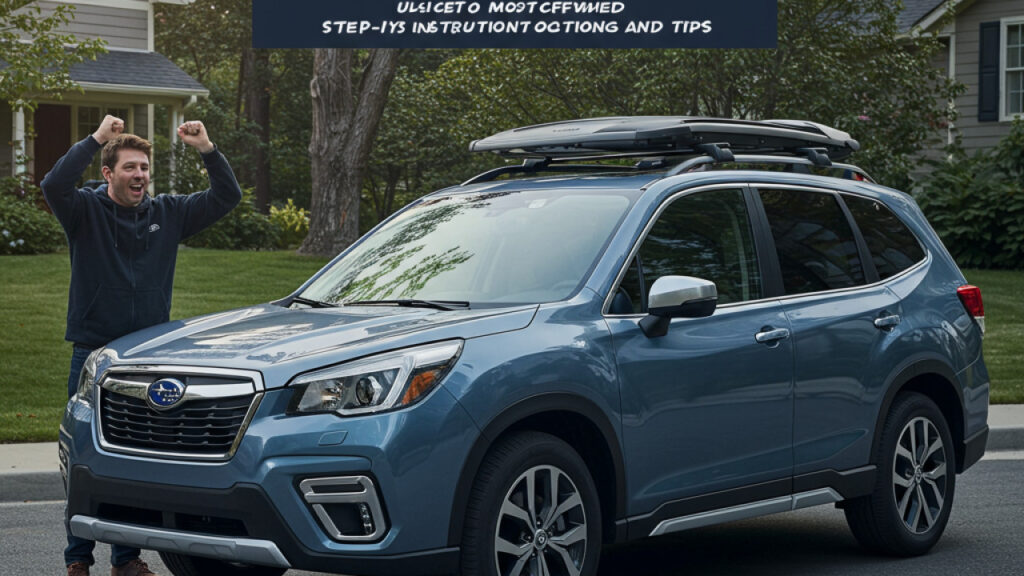Introduction
Installing roof rails on your 2025 Subaru Forester can significantly enhance its functionality and appearance. Roof rails provide a sturdy framework for securing various accessories, such as cargo boxes, bike racks, and kayaks. This guide will walk you through the entire installation process, offering tips, practical examples, and answers to frequently asked questions.
Why Install Roof Rails?
Before diving into the installation process, it’s essential to understand the benefits of having roof rails:
- Increased Storage Capacity: Roof rails allow you to transport larger items, freeing up interior space.
- Versatility: They can be used with various accessories, including cargo baskets and ski racks.
- Aesthetic Appeal: Roof rails enhance the overall look of your vehicle, giving it a rugged, adventurous vibe.
Tools and Materials Needed
Before you start, ensure you have all the necessary tools and materials:
Tools:
Socket wrench set Torque wrench Drill (if required) Measuring tape Level Safety goggles Materials:
- Roof rail kit (specific to the 2025 Subaru Forester)
- Mounting brackets
- Bolts and screws (included in the kit)
- Sealant (if required)
Step-by-Step Installation Instructions
Step 1: Preparation
Before you begin the installation, ensure that your workspace is clean and that you have everything ready. Read the manufacturer’s instructions that come with your roof rail kit thoroughly.
Step 2: Position the Roof Rails
1. Place the roof rails on the roof of your Forester where you intend to install them. Use a level to ensure they are straight.
2. Measure and mark the points where the mounting brackets will be attached. It’s crucial to double-check the measurements to avoid any misalignment.
Step 3: Install Mounting Brackets
1. Depending on your kit, you may need to drill holes for the mounting brackets. If drilling is required, wear your safety goggles and follow the manufacturer’s guidelines for hole placement.
2. Attach the mounting brackets using the provided bolts and screws. Use a torque wrench to tighten them to the manufacturer’s specifications to ensure they are secure.
Step 4: Attach the Roof Rails
1. Align the roof rails with the installed brackets. Make sure they are evenly spaced and level.
2. Secure the roof rails to the brackets using the provided hardware. Ensure all connections are tight.
Step 5: Final Adjustments and Sealant
1. Once everything is installed, double-check to ensure that the roof rails are secure and aligned correctly.
2. If your installation requires sealant, apply it around the mounting points to prevent water leaks.
Step 6: Testing the Installation
Before you load any cargo, it’s crucial to test the installation:
- Check for any movement or wobbling in the roof rails.
- Ensure that all bolts and screws are secure.
Practical Examples and Real-World Applications
Roof rails are not just for aesthetic purposes; they serve multiple practical functions:
Transporting Outdoor Gear
If you enjoy biking or kayaking, roof rails can accommodate bike racks or kayak carriers. For instance:
- Bike Racks: A standard bike rack can be mounted on your roof rails, allowing you to transport multiple bikes securely.
- Kayak Carriers: Roof rails can support kayak carriers, making it easy to transport your kayak to the nearest water body.
Enhanced Cargo Capacity
For road trips or camping adventures, roof rails can hold cargo boxes that provide additional storage space for luggage, camping gear, or sports equipment.
Frequently Asked Questions (FAQ)
What is the weight capacity of roof rails on the 2025 Subaru Forester?
The weight capacity of roof rails typically ranges between 150 to 200 pounds, depending on the manufacturer. Always check the specifications provided with your roof rail kit to ensure safe loading.
How do I maintain my roof rails?
To maintain your roof rails:
- Regularly inspect for any signs of rust or wear.
- Clean them with mild soap and water to remove dirt and debris.
- Ensure all bolts and screws are tight and reseal as necessary.
Can I install roof rails myself, or should I hire a professional?
While installing roof rails can be a DIY project, it’s recommended for those with some mechanical experience. If you’re unsure or uncomfortable, hiring a professional ensures proper installation.
What are the differences between factory-installed and aftermarket roof rails?
| Factor | Factory-Installed Roof Rails | Aftermarket Roof Rails |
|---|---|---|
| Quality | OEM quality | Varies by manufacturer |
| Fit | Designed specifically for the vehicle | May require adjustments |
| Cost | Generally more expensive | Often more affordable |
| Warranty | Typically covered by manufacturer warranty | Depends on the aftermarket brand |
Are roof rails compatible with all accessories?
Not all roof accessories are compatible with every roof rail system. Always check the compatibility of accessories with your specific roof rail model to ensure a secure fit.
Conclusion
Installing roof rails on your 2025 Subaru Forester is a worthwhile investment that adds both functionality and style to your vehicle. By following this comprehensive guide, you can confidently install roof rails and enhance your vehicle’s versatility for outdoor adventures. Remember to adhere to safety guidelines, regularly maintain your roof rails, and enjoy the added convenience they bring to your travels.
Key takeaways include:
- Roof rails enhance storage capacity and versatility.
- Proper installation is crucial for safety and functionality.
- Regular maintenance will extend the life of your roof rails.

